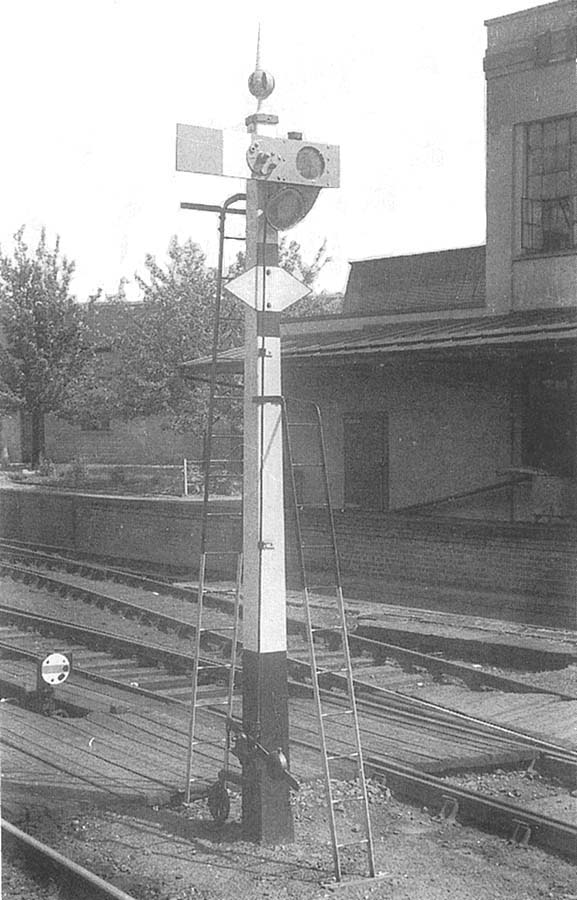GWR Route: Moreton-in-Marsh to Shipston-on-Stour
Moreton-in-Marsh Station: gwrmm998
 |
View of the Moreton-in-Marsh down main starter, which
because it was situated at a relatively low height in the restricted space
between the up and down running lines was provided with a central pivoted arm.
The low height was necessary in order for the signal to be visible under the
footbridge. This signal was controlled by lever 3 in the Moreton-in-Marsh
Signal Box. Starting signals are located at the end of platforms or in advance
of trailing points. In this position they protect the entrance to the next
section, and trains may therefore draw up to them during shunting operations.
For this reason they should be at least a full train-length in advance of the
trailing points. This is in order that a driver should not have to pass the
signal at danger when backing the train through a trailing cross-over. If this
cannot be done an advanced starting signal needs to be provided to give the
necessary protection and this was the case at Moreton-in-Marsh where an
advanced starter controlled electrically by lever 6 in the Moreton-in-Marsh
Signal Box was provided.
An important railway rule had been framed to guard against
the possibility of a signalman forgetting that a train or engine was waiting at
his signals. This Rule 55 was amended as technology (largely in the guise of
track circuiting), developed and this can be seen in the changes detailed
below:
The Rules and Regulations (issued 1st January 1913)
required in Rule 55(a) 'In the case of detention at a Home, Starting or
Advanced Starting Signal, the Engine-driver must immediately sound his whistle
and if still detained, the Guard, Shunter or Fireman must (except where
instructions are given to the contrary) go into the Signal box and remind the
Signalman of the position of the train, and remain there until the Signalman
can give permission for it to go forward.'
The Rules and Regulations (issued 1st January 1923)
contained the amended requirement in Rule 55(a) 'In clear weather when a
train has been brought to a stand owing to a Home, Starting, or Advanced
Starting Signal at Danger, Driver must sound the engine whistle, and, if still
detained, the Guard, Shunter or Fireman must (except where printed instructions
are given to the contrary) go to the Signal-box and remind the Signalman of the
position of the train, and, except as provided for in clause (f), remain there
until the Signalman can give permission for it to go forward. In no case
(except where printed instructions are given to the contrary as stated above)
must the train stand more than three minutes at a Signal before the man goes to
the Signal-box.
NOTE.- AT A NUMBER OF SIGNALS EITHER TRACK CIRCUITING,
FOULING BARS, OR REPLY PUSH BELLS HAVE BEEN PROVIDED TO REMIND SIGNALMEN OF THE
PRESENCE OF TRAINS OR ENGINES AND IT IS CONSEQUENTLY UNNECESSARY AT THESE
PLACES FOR TRAINMEN TO GO TO THE SIGNAL-BOX TO CARRY OUT THE PROVISIONS OF RULE
55.
NOTICE BOARDS (ILLUMINATED AT NIGHT) LETTERED “TRAIN
INDICATOR IN BOX” OR “BELL TO BOX” HAVE BEEN PROVIDED AT OR NEAR
THESE SIGNALS AS A REMINDER TO TRAINMEN THAT THEY NEED NOT GO TO THE SIGNAL-BOX
TO INFORM THE SIGNALMAN OF THE POSITION OF THE TRAIN OR ENGINE.'
The Rules and Regulations (issued 1st January 1933)
had an identical Rule 55(a), but the second paragraph of the note had been
amended to state 'White enamelled notice plates, diamond shaped, or
“Bell to Box” indicators have been provided at or near these signals
as a reminder to Trainmen that they need not go to the signal box to inform the
Signalman of the position of the train or engine except that the engine whistle
must be sounded in accordance with the Rule.'
The Moreton-in-Marsh Signal Diagram ('gwrmm3173') indicates a track circuit (4T) was
provided through the down platform to exempt the train's crew from Rule 55 when
being detained by this down starter signal. Initially lever collars were
dropped over the protecting signal lever and/or the flaps were dropped on the
block instrument to act as a physical reminder to the Signalman. Later the
track circuit was interlocked with the down main inner home signal (lever 4) to
prevent this from being moved from danger unless the track circuit monitored
section was clear. The presence of this track circuit is indicated to the
driver by the white diamond symbol on the signal post.
Finally on the other side of the barrow crossing is a
ground disc signal associated with accessing the trailing cross-over from the
up line. This ground disc signal was controlled by lever 31 in the
Moreton-in-Marsh signal box.
Robert Ferris
 back back

|
